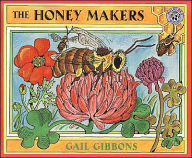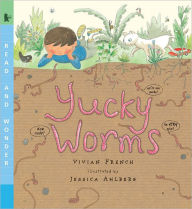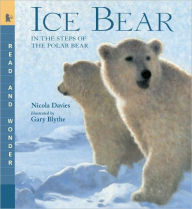Follow the flight of a honey bee as she searches for nectar to sustain her hive and, along the way, pollinates flowers to produce seeds and fruits.
A tiny honey bee emerges from the hive for the first time. Using sunlight, landmarks, and scents to remember the path, she goes in search of pollen and nectar to share with the thousands of other bees in her hive. She uses her powerful sense of smell to locate the flowers that sustain her, avoids birds that might eat her, and returns home to share her finds with her many sisters. Nature lovers and scientists-to-be are invited to explore the fascinating life of a honey bee.
Back matter includes information about protecting bees and an index.
From the Publisher
This brightly illustrated picture book achieves a good deal. The lively, realistic story is enhanced with apt imagery and vivid turns of phrase. Meanwhile, small-type sentences on each spread add intriguing related facts about honey bees. ... One of the most informative picture books about honey bees, this is surely among the most beautiful as well.
—Booklist (starred review)The prose is polished and informative and the secondary tidbits are often quite fascinating. Lovelock’s mixed-media art is simply stunning, pairing compositions of vigorous graphic strength with delicate watercolor mottling and precise biological detail.
—Bulletin of the Center for Children's Books
Huber's language is descriptive and gorgeously reminiscent of the bee's flight itself. Every page also offers facts about bumble bees and their behavior. Watercolor, acrylic ink, and colored pencil illustrations are bright and bold; reader's will almost feel the warmth and comfort inside the golden hive.
—Library Media Connection
Children's Literature - Meredith Kiger
The magical world of honey bees is brought to life as the author follows a particular honey bee on her daily rounds to collect nectar. “Scout” leaves the hive and the story follows her through the dangers of predators and bad weather as she collects pollen and nectar and returns to the hive. Scout’s mission as a worker within the hive and her relationship to the other bees is described. The story portrays the life cycle of bees while additional, smaller text on each page provides scientific facts about the life of bees and their importance to humans. The amazing water color illustrations bring the tiny bees up close for readers to enjoy. Emphasis is placed on bees as a family working together to get the job done. A section on how to protect bees as a resource, an index and information about the author and illustrator are included. A fascinating look on the life of bees that will be enjoyed by both children and adults. Reviewer: Meredith Kiger, Ph.D. AGERANGE: Ages 7 to 9.
School Library Journal
09/01/2013
K-Gr 2—On a golden fall day, a bee makes her first flight as scout, looking for flowers for the bees in her hive to harvest. Focusing on the insect's journey, the story introduces the shared work of the bee colony and the basic scheme of honey production. "An arresting smell drifts on the breeze. Scout locks onto this scent" and soon finds herself in "an ocean of flowers." Not all of the quest is pretty. There's an attacking blackbird and a thunderstorm from which the bee must find protection. The well-paced text is set in warm, bright scenes. The realistic figure of the bee contrasts with soft, impressionistic backgrounds in orange and gold, blue and green hues. The narrative, set to one side or the other of the spread, is accompanied by a bit of straightforward, factual explanation in smaller, italicized type. Scout carries the pollen back to her hive, dancing instructions to her sister bees, who then fly off to gather the precious nectar. There are many fine books on this insect, but this one will be welcome in libraries that can use just a little more for children in the early grades. Huber provides an opening note on the importance of the bee as "the planet's greatest pollinator" and closes with a cautionary note that "honey bees are dying out." He doesn't mention the current debacle of collapsing bee colonies in the U.S. (he's from New Zealand), but he does advise young readers on simple steps to help pollinating insects.—Margaret Bush, Simmons College, Boston
Kirkus Reviews
2013-08-15
A New Zealand import describes a worker honeybee‘s scouting mission. Naming his protagonist Scout for her current role in the hive, Huber delivers a present-tense narrative of her odyssey. It is fall, and Scout seeks its "last flowers." Through winds and past a hungry black bird, she finds a "sea of flowers" from which she gathers nectar and pollen. A sudden hailstorm temporarily grounds her, and when she arrives home, guard bees are battling a wasp that's attempting to rob the hive. Once inside, she does her waggle dance so her "sister bees" can find her meadow and harvest enough nectar to make honey for the winter. Running alongside the narrative of Scout's day are supplemental facts about the science of bees (flying charges them with static electricity, attracting pollen, for instance), and a brief author's note and index provide additional informational heft. The text at times strains under figurative language that's not quite right--the bees "flick from the hive like golden pebbles"--but by and large, it succeeds in accurately dramatizing honeybee behavior. Lovelock's full-bleed paintings, done in watercolor, acrylic ink and colored pencil, vary in perspective and scale, making the most of the autumn palette and refraining at all times from anthropomorphizing their subjects. While hardly the only bee book available, this handsome, respectful volume deserves a place on the shelf. (Informational picture book. 3-7)
Read More
















